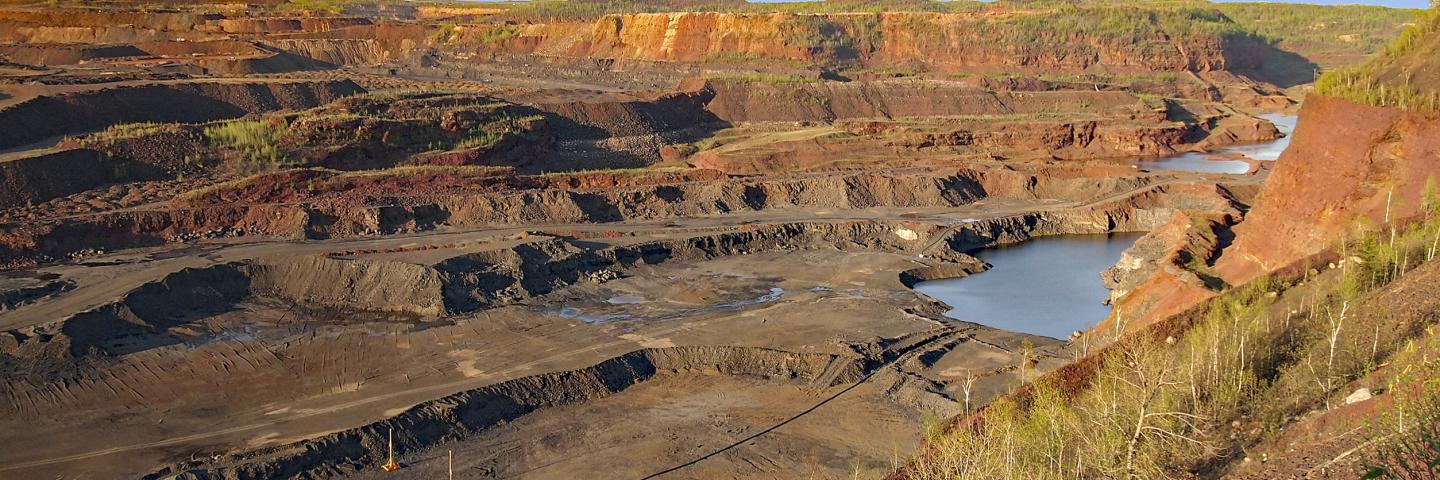The northeast region of Minnesota is home to the state’s metallic mining industry. The "Iron Range" has a history of iron ore (“ferrous”) mining dating back to the late 1800s and includes the large taconite mining and production facilities that are currently in operation such as Minntac and Hibbing Taconite. This area of the state also has several copper, nickel and precious metal deposits that are currently being explored or proposed for development. This mining is often referred to as "non-ferrous mining" (or by some as “sulfide mining”) and includes the proposed PolyMet and Twin Metals Minnesota projects.
All mining projects in Minnesota must obtain various air and water permits or certifications from the MPCA (in addition to several other permits from the Minnesota Department of Natural Resources) in order to operate. Only after the company submits a formal proposal to state and federal agencies, can the environmental review and permitting processes begin. New mining projects can take several years to complete environmental review and obtain all of the necessary permits and approvals before construction can begin. For new projects, the public is afforded multiple opportunities to provide input and comment during the review and permitting processes. There is additional opportunity for public involvement when the MPCA permits come up for reissuance, usually after a period of five years, or a major amendment.
After a mine receives their permits and certifications from the MPCA, they must adhere to the requirements or face enforcement actions, which can include fines and/or corrective actions to remedy the situation.
See Local sites and projects for current mining projects.
Environmental review
The MPCA participates in environmental review for mining projects where, most commonly, the Minnesota Department of Natural Resources is the responsible governmental unit. Environmental review is a prescriptive process that has two primary goals:
- Consider the impacts of the project to the human and the environment
- Engage stakeholders and the public on the project impacts
During environmental review, scientific subject matter specialists with expertise in topics like wetlands, habitat, cultural and historic resources, economics and air quality assess the potential environmental impacts associated with a project and may consider whether alternative project scenarios could reduce potential impacts and still meet project goals. They do this by preparing an Environmental Assessment Worksheet (EAW) or, for larger projects, an Environmental Impact Statement (EIS).
For more information about environmental review, visit:
- Environmental review
- DNR’s environmental review page
- CEQ Citizen’s Guide to the NEPA
- EQB Guidance for Citizens, Environmental Review under MEPA
- Advisory Council on Historic Preservation Guide to NHPA Section 106
Permitting
Once environmental review is complete, projects must undergo permitting review. The MPCA issues the following permits/certifications that may be needed for mining operations:
- Air quality
- Water quality
- Solid waste
- Hazardous waste storage and transportation
- Above- and below-ground storage tanks
- Section 401 certification
Permits include enforceable requirements about how the facilities are constructed, operated and eventually closed. Permits also have extensive requirements for monitoring and reporting to the MPCA during operations to ensure the facility is in compliance.
Air permitting
MPCA issues air quality permits to comply with federal and state rules and regulations. Air permits issued identify the various emission sources at each mining facility that generate air pollutants and, where applicable, place limits on those emissions. Air permits also contain performance testing and recordkeeping to demonstrate compliance with conditions listed in the issued air permits. Permits issued to mining facilities control air emissions from crushing and handling of rock, combustion sources such as furnaces or space heaters, and fugitive dust from material handling, unpaved roads, and/or tailings basins.
Learn more about air quality permits.
Water permitting
MPCA water quality permits establish specific discharge limits and requirements to protect Minnesota's surface and groundwater quality for a variety of designated uses, such as drinking water, fishing and recreation. Water quality permitting includes the National Pollutant Discharge Elimination System (NPDES) permits required under the federal Clean Water Act as well as State Disposal System (SDS) permits required by Minnesota law. Learn more:
Section 401 certification
MPCA also uses Section 401 certification to protect water quality. Any project with a discharge that needs a federal permit or license, such as a permit to dredge or fill wetlands or surface waters, also needs a Section 401 certification. The 401 certification is part of a larger water quality protection effort that is an integral part of the Federal Clean Water Act. The program often works closely with other agencies that play a role in water quality protection, including the U.S. Army Corps of Engineers, DNR, Minnesota Board of Soil and Water Resources, and local government agencies
